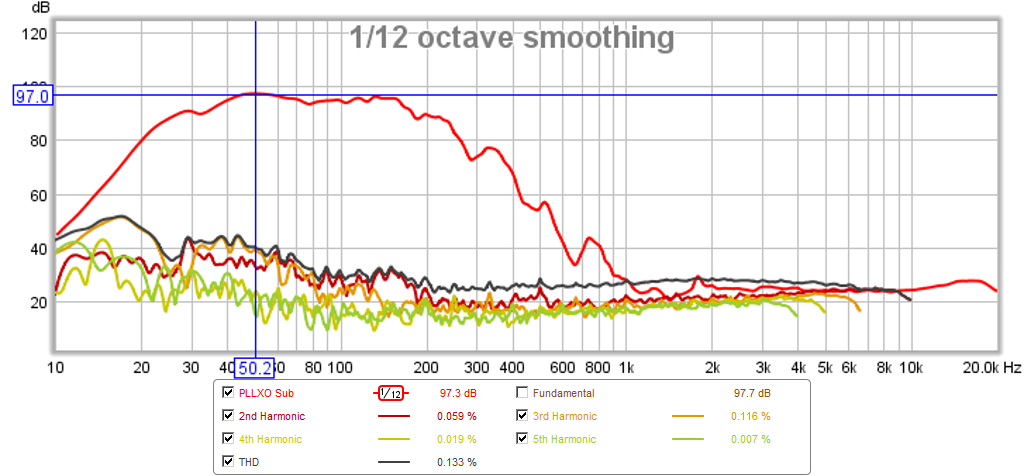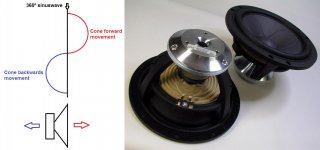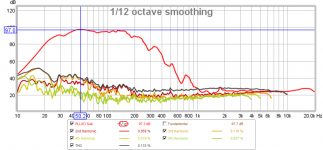bushmeister,
UM15-22 is in stock in Sweden and Germany but not as cheap as US costumers can get it at PE.
Sweden: Dayton Audio UM15-22
Germany: https://www.intertechnik.com/Shop/Loudspeakers/Dayton/Dayton-Subwoofer/_UM15-22_1768,en,7053,149005
Ideas in 15" range is PM Overkill Audio regarding PD.1550 or PD155N01 which should be available in UK but not cheap either, special is impedance resonance is up in midrange so sub area is free of impedance resonance bumb.
UM15-22 is in stock in Sweden and Germany but not as cheap as US costumers can get it at PE.
Sweden: Dayton Audio UM15-22
Germany: https://www.intertechnik.com/Shop/Loudspeakers/Dayton/Dayton-Subwoofer/_UM15-22_1768,en,7053,149005
Ideas in 15" range is PM Overkill Audio regarding PD.1550 or PD155N01 which should be available in UK but not cheap either, special is impedance resonance is up in midrange so sub area is free of impedance resonance bumb.
Keep the sub close to the floor, use it, don't fight it. I probably would have picked 2 smaller drivers.
Is height off the floor such a concern if the sub is running from 50 hz down?
If running 50Hz down you could aim it at the floor even with 2in high feet for standing the box off the floor. It's all omni that low.
One thing to watch out for with sealed subs is that I think there is more distortion due to the non-linear air compression effect from Boyle's law. The "in" stroke is different than "out" stroke due to pressure and volume being inversely related. The more motion the cone has, the more apparent and as this is a below 50Hz sub, large cone motions are the norm.
Have you considered an open baffle dipole sub with a 15in H frame? Less SPL capability, but fewer issues with room modes and it sounds less distorted and transients are very good.
One thing to watch out for with sealed subs is that I think there is more distortion due to the non-linear air compression effect from Boyle's law. The "in" stroke is different than "out" stroke due to pressure and volume being inversely related. The more motion the cone has, the more apparent and as this is a below 50Hz sub, large cone motions are the norm.
Have you considered an open baffle dipole sub with a 15in H frame? Less SPL capability, but fewer issues with room modes and it sounds less distorted and transients are very good.
If running 50Hz down you could aim it at the floor even with 2in high feet for standing the box off the floor. It's all omni that low.
One thing to watch out for with sealed subs is that I think there is more distortion due to the non-linear air compression effect from Boyle's law. The "in" stroke is different than "out" stroke due to pressure and volume being inversely related. The more motion the cone has, the more apparent and as this is a below 50Hz sub, large cone motions are the norm.
Have you considered an open baffle dipole sub with a 15in H frame? Less SPL capability, but fewer issues with room modes and it sounds less distorted and transients are very good.
Nonlinear air compression in real-world subs is a non issue. It's swamped by suspension and motor nonlinearity.
.....One thing to watch out for with sealed subs is that I think there is more distortion due to the non-linear air compression effect from Boyle's law. The "in" stroke is different than "out" stroke due to pressure and volume being inversely related. The more motion the cone has, the more apparent and as this is a below 50Hz sub, large cone motions are the norm......
Have never asked Overkill Audio but above could be why he recommend by hand tune sealed box with small volume fillers to exactly hit Q 0,7071, also his recommended woofer drivers have enormous SD area so stroke would not be much when used in home audio and also those two drivers hinted to bushmeister takes only around 25/27 liters without stuffing and is good for 600/700 watts.
Use tight floor reflection, nothing more behind that statement... That's why I'd want two drivers in between to have everything close, and two subs firing as one. Light cone, strong motor.Is height off the floor such a concern if the sub is running from 50 hz down?
Nonlinear air compression in real-world subs is a non issue. It's swamped by suspension and motor nonlinearity.
Maybe so but I have noticed increased distortion in sealed vs open baffle or open back boxes with same driver. Even with well damped boxes with appropriate sound absorbing materials on walls and fiberglass fill.
Maybe so but I have noticed increased distortion in sealed vs open baffle or open back boxes with same driver. Even with well damped boxes with appropriate sound absorbing materials on walls and fiberglass fill.
If it's enclosure pressure you're battling,
aperiodic might be a solution, depending on the drivers and the practical drawbacks of this alignment.
Alternatively, a stuffed + aggressively tapering TL might address the rear chamber pressure issues in essentially the same manner + a bit of LF gain, at the cost of size.
Last edited:
Maybe so but I have noticed increased distortion in sealed vs open baffle or open back boxes with same driver. Even with well damped boxes with appropriate sound absorbing materials on walls and fiberglass fill.
Makes me think about open construction with many top end products as these ILLUMINATOR or SATORI, more open baffle : )
Seen wesayso link to some klippel tests for these somewhere they seems perform better symmetry but is costly.
So going a step up in quality for woofers with your new RS180P-8 would probably be better into sealed as the SB23NRXS45-8 woofers bushmeister use.
Wonder if we can see this unsymmetrical troubling simply by making a near field measurement with REW and after that change polarity for speaker cable at power amp and run same measurement. Overlaying those two measurements and invert one of them should show exactly same data in all the different measurement windows into REW including HD, and if not one of the directions for cone has trouble that need to be looked at is a thought.
Attachments
We've done this countless times when measuring and listening to sealed subwoofer systems.......you simply cannot discern harmonic distortion below 20% for frequencies below 100hz. I really wanted to believe otherwise as I was all about hemholz systems and their greater efficiency.........but it wasn't meant to be. Keep the system linear and it's all good.
Maybe so but I have noticed increased distortion in sealed vs open baffle or open back boxes with same driver. Even with well damped boxes with appropriate sound absorbing materials on walls and fiberglass fill.
I'm a little confused as to your assessment and comparison........if we're talking the same driver, the same level and the same F3?.......don't know of too many OB dipoles that hit 50hz and below if any. Are we talking true subwoofer drivers here?
Maybe you were hearing suspension noise or enclosure resonances?
I can hear the difference easily between 0.5% or 3% HD at 80Hz or 60Hz. 20% is insanely bad bass that doesn't sound good to me. If you have bass horns capable of 0.3% HD at 50Hz at 100dB, trust me - it sounds so clean and unlike a sealed or reflex sub with 3% HD you are used to hearing you would ask where's the bass? We are so used to distorted bass we accept that is what bass sounds like. When it is clean, we perceive the SPL as not as loud. But it does not really sound like that. The same happens at the higher frequencies. A tractrix can play 500Hz to 10kHz at 100dB and 0.1% THD that you don't realize how loud it is.
I'm a little confused as to your assessment and comparison........if we're talking the same driver, the same level and the same F3?.......don't know of too many OB dipoles that hit 50hz and below if any. Are we talking true subwoofer drivers here?
Maybe you were hearing suspension noise or enclosure resonances?
Plenty of OB's go below 50Hz. Look at all the Alpha 15's in H frames. My Kazba z baffle dipole. The open back versions of the horns in this thread before the box was put on went to 30Hz. Slot loaded open baffles. You have a misperception of bass extension with OB's. They just don't pressurize a room so it sounds weak when far away. Near field though they can dig deep.
I don't think suspension noise can generate higher harmonics as I used sine test tone and looked at RTA - true harmonics were generated - which is not broadband noise.
I can hear the difference easily between 0.5% or 3% HD at 80Hz or 60Hz. 20% is insanely bad bass that doesn't sound good to me. If you have bass horns capable of 0.3% HD at 50Hz at 100dB, trust me - it sounds so clean and unlike a sealed or reflex sub with 3% HD you are used to hearing you would ask where's the bass? We are so used to distorted bass we accept that is what bass sounds like. When it is clean, we perceive the SPL as not as loud. But it does not really sound like that. The same happens at the higher frequencies. A tractrix can play 500Hz to 10kHz at 100dB and 0.1% THD that you don't realize how loud it is.
Good clean bass can give an enormous power to the midrange when the timing is right. Never knew how much until I got it pretty much right. It makes the instruments sound more powerful and lets you worry less about things like bass, mid, tweeter frequencies etc. It makes music together! Does the POP genre good justice too!
No misperceptions here.......and can't really find a scenario where I'd be listening to 15" woofer on wide baffles near field to get limited extension
I'm kinda surprised you used the rediculously weak motored Alpha 15 as an example of quality OB bass.
My assesment for bass distortion wasn't just my perception, or a couple of DIYers getting together for a listen. It was commercial pro testing of multiple sealed subwoofers for an installation in a cathedral in lower NYC. They're used to recreate LF pipe organ tones. A LOT of r and d went into this........sorry but i simply can't agree with anything you've mentioned in regards to the audibility of HD as this was control tested with consistent results.
I'm kinda surprised you used the rediculously weak motored Alpha 15 as an example of quality OB bass.
My assesment for bass distortion wasn't just my perception, or a couple of DIYers getting together for a listen. It was commercial pro testing of multiple sealed subwoofers for an installation in a cathedral in lower NYC. They're used to recreate LF pipe organ tones. A LOT of r and d went into this........sorry but i simply can't agree with anything you've mentioned in regards to the audibility of HD as this was control tested with consistent results.
I've read somewhere: bass should be felt, not (or more than) heard, can't remember where. I think I can go a long way in agreeing to that statement.
People will always have different perceptions. Nothing wrong with aiming for clean bass I'd say. If you can do it, why not? One less thing to worry about... 🙂
People will always have different perceptions. Nothing wrong with aiming for clean bass I'd say. If you can do it, why not? One less thing to worry about... 🙂
Of course.........clean bass within reason and extension for the purpose. But there's always Hoffman looking over your shoulder reminding you how difficult this is. I always get a kick outta some audiophile sites and reviewers that drive 2way bookshelf speakers with $10k worth of front end gear sacrificing half an octave or useable response talking about bass that's 'tight', 'fast', ya dada yadda yadda........what is 'fast' bass exactly? Lol
Fast bass? I say one that's done after ~3 to 7 ms at 25 Hz... Fast enough for you?

😀, just kidding, or am I? 😉

😀, just kidding, or am I? 😉
Alpha 15 is a weak motor high Qts driver - exactly what you need to get deep bass extension with an OB. I don't have one but know of many people who use it as their main bass for OB because of its very high sensitivity. I don't see why you would disparage it as bad sounding OB bass unless you know it to have bad distortion (which can't be the case as you say you can't hear distortion below 100Hz).
I don't doubt that the cathedral project you worked on spent a lot of R&D looking at this. I know it makes a difference to me because I can hear it.
Have you taken the Klippel online distortion audibility test? My ears are sensitive to HD down to -45dB. Most people are circa -21dB or about a little under 10% - which is why they spec amplifier power at 10% THD levels. "Most" people can't hear any difference below that. I guess I am an exception.
If you can get 97dB at 1m with circa 0.13% THD, why not? It's hard to go back to dirty bass once you have heard bass like this.

I don't doubt that the cathedral project you worked on spent a lot of R&D looking at this. I know it makes a difference to me because I can hear it.
Have you taken the Klippel online distortion audibility test? My ears are sensitive to HD down to -45dB. Most people are circa -21dB or about a little under 10% - which is why they spec amplifier power at 10% THD levels. "Most" people can't hear any difference below that. I guess I am an exception.
If you can get 97dB at 1m with circa 0.13% THD, why not? It's hard to go back to dirty bass once you have heard bass like this.

Attachments
Last edited:
- Home
- Loudspeakers
- Multi-Way
- A Bookshelf Multi-Way Point-Source Horn

